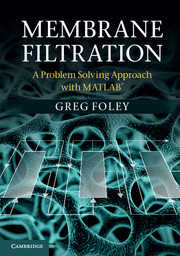Book contents
- Frontmatter
- Dedication
- Contents
- Preface
- Abbreviations
- 1 Introduction to membrane filtration of liquids
- 2 Dead-end filtration
- 3 Crossflow microfiltration
- 4 Ultrafiltration flux theories
- 5 Ultrafiltration process analysis and design at the limiting flux
- 6 Diafiltration at the limiting flux
- 7 Ultrafiltration and diafiltration with incomplete rejection
- 8 The osmotic pressure model applied to ultrafiltration and diafiltration
- 9 Reverse osmosis and nanofiltration
- 10 Membrane fouling
- Appendix Mathematical and computational background
- Index
- References
1 - Introduction to membrane filtration of liquids
Published online by Cambridge University Press: 05 July 2013
- Frontmatter
- Dedication
- Contents
- Preface
- Abbreviations
- 1 Introduction to membrane filtration of liquids
- 2 Dead-end filtration
- 3 Crossflow microfiltration
- 4 Ultrafiltration flux theories
- 5 Ultrafiltration process analysis and design at the limiting flux
- 6 Diafiltration at the limiting flux
- 7 Ultrafiltration and diafiltration with incomplete rejection
- 8 The osmotic pressure model applied to ultrafiltration and diafiltration
- 9 Reverse osmosis and nanofiltration
- 10 Membrane fouling
- Appendix Mathematical and computational background
- Index
- References
Summary
Introduction
This book is largely concerned with solving process problems in the membrane filtration of liquids. In that sense, it is more a chemical engineering book than a membrane science book. There are many fine books available which provide much more information on membrane synthesis and structure, module design, transport processes in membranes and applications of membrane technologies in industrial and medical processes [1–4].
Nonetheless, a small amount of background on membrane separations is needed before the business of process modelling, analysis and design can begin. So, in this chapter, some general terminology is defined, membranes and modules are described and some of the main characteristics of the various membrane filtration techniques are outlined.
A membrane is simply a physical barrier through which pure solvent can pass while other molecules or particles are retained. In the case of ultrafiltration (UF) and microfiltration (MF) this semi-permeability is largely a result of the relative sizes of the solute/particles and the membrane pores. Solute retention is a little different in reverse osmosis (RO) and is largely determined by charge effects. The RO membrane can be thought of as a matrix through which solvent and solute diffuse at different rates. Nanofiltration (NF) occupies a transition zone between UF and RO and solute retention is complex, involving both size and charge effects.
- Type
- Chapter
- Information
- Membrane FiltrationA Problem Solving Approach with MATLAB, pp. 1 - 15Publisher: Cambridge University PressPrint publication year: 2013



